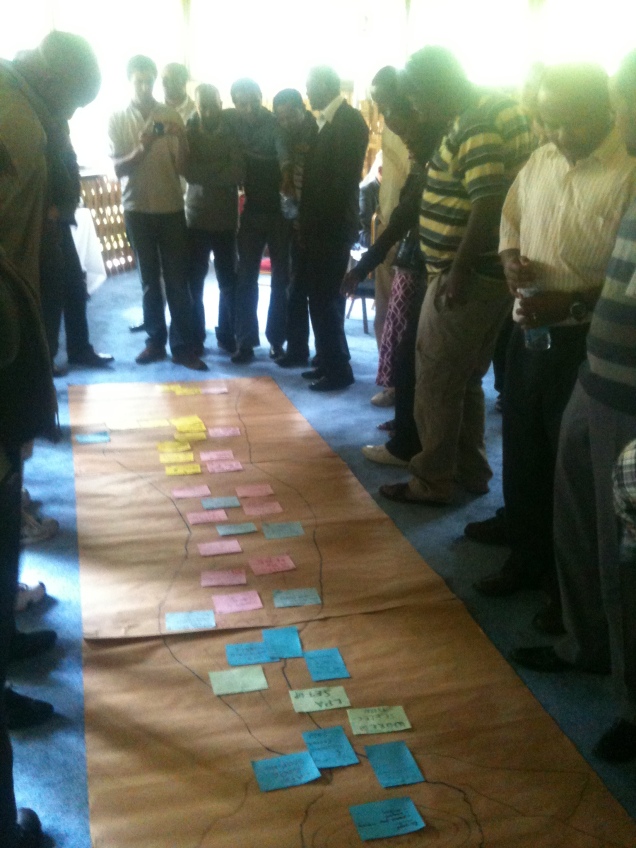When we’re working together we need to have access to relevant information. Finding out what we know is partly to do with getting the relevant information on the table – the data and facts. But it’s also about tapping into the stuff that’s less tangible – the knowledge that’s wrapped into people’s experience and memories – and making this visible. In other words it’s about bringing people’s voices and their different experiences into the room, in a spirit of curiosity and learning. It’s that process we’re exploring in the second of the seven broad categories we’re using to help organise the material the Facilitation Anywhere training programme.
River of life
This combination of tangible and intangible is often best surfaced using a visual metaphor such as a journey, timeline or map. Pete worked for the wonderful Ewen Le Borgne (seen below taking a photo) on an end-of-project review meeting in Ethiopia (the first five years of RIPPLE Ethiopia) 
Simply drawing a river on rough paper, and having people put up significant moments that represented the progress of the project – and the connections, links and people with whom they worked – enabled current and past members of the project team to come back together quickly. The group was energised and spent a long time sharing and laughing after the model had been constructed. And as we went onto the rest of the workshop it was striking to see how much had come into the room with the exercise – the memories, tensions, high points and disappointments that had characterised the process were there to be ‘used’: to be talked about, to form the basis for planning and learning lessons for other projects. (More about River of Life in the KS Toolkit we shared in our last post).
Presentations can be fun too, really!
Presentations are at the other end of the spectrum for finding out what we know. Well-organised, visual, strictly-timed presentations that are integrated into participative activities can be very effective in bringing large amounts of information and data into meetings, both online and face to face. Though, as we all know, long, turgid, over-factual and droning presentations outnumber good ones. Banning powerpoint can work with an audience ready to experiment but there are lots of situations where participants expect and value formal presentations, especially important for national staff who haven’t attended many international meetings.
The nightmare for a facilitator is that ‘please facilitate this agenda’ job, where by the time the facilitator is engaged, the organiser has already contacted loads of presenters, who are busy preparing 50-slide decks. Ewen Le Borgne is a model of someone who ‘works out loud’ and his blogs are a constant source of ideas and provocations. Here’s one describing exactly that situation and how they managed it.
Online, you have 60 – 90 seconds to keep my attention
For online meetings the issues are more acute. All of the above applies but there are all the other issues that matter when the meeting is not face to face. Here’s an excellent resource, suggested by the peerless Nancy White. Susan Stewart highlights just how careful we need to be if we use these traditional tools in online meetings or webinars and provides some very useful rules of thumb for comparing face to face and online activities.
Being the facilitator
Curious, collaborating, challenging, creative…..
Through the collaborative process of developing the training programme we’ve had to find out what we each know, both practically in terms of approaches and methods but also, more significantly, what we know works and how we know it. This latter exemplifies the more intuitive, deeper set of ideas that have to come into the room in meetings and workshops if the participants are to exploit to the maximum their experience and wisdom. We’re curious about how each other works and we’ve also found that working together has been wonderfully challenging, of each other’s comfort zones, old assumptions, regular ways of doing things (“I always start with…..”). In the same way, we need to enable participants to position themselves outside their normal way of being at work:
- to locate their ‘beginner’s mind’ – come with a curiosity about every new venture, make no assumptions, begin afresh and ask lots of questions, to bring a spirit of curiosity into the space
- to recognise and adopt a stance that will maximise shared learning, well put in this snippet about Mutual Learning

What are you curious about? What could you do differently with your group this time?

